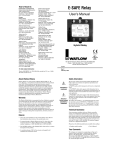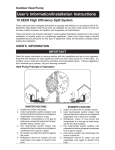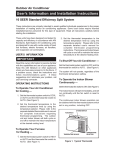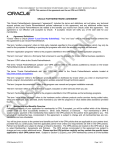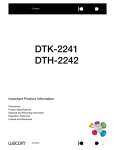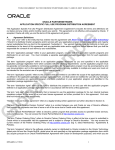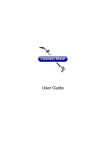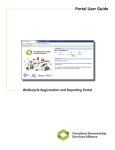Download Tires - Inspection Services of America
Transcript
Wheel & Tire Supplement Uniform Inspection & Communication Standards 2008 - 2009 Uniform Inspection & Communication Standards These materials are confidential and are not to be disclosed to, or utilized by, any individual or entity other than participants of the Motorist Assurance Program (MAP). The Automotive Maintenance and Repair Association (AMRA) and MAP do not warrant these materials or guarantee their accuracy, and AMRA and MAP assume no liability for errors. © 2008 Automotive Maintenance and Repair Association January 2008 Uniform Inspection & Communication Standards Motorist Assurance Program (MAP) Overview The Motorist Assurance Program is the consumer outreach effort of the Automotive Maintenance and Repair Association, Inc. (AMRA). Participation in the Motorist Assurance Program comes from retailers, suppliers, independent repair facilities, vehicle manufacturers and industry associations. Our organization's mission is to strengthen the relationship between the consumer and the auto repair industry. We produce materials that give motorists the information and encouragement to take greater responsibility for their vehicles—through proper, manufacturer / recommended maintenance. We encourage participating service and repair shops (including franchisees and dealers) to adopt (1) a Pledge of Assurance to their Customers and (2) the Motorist Assurance Program Standards of Service. All participating service providers have agreed to subscribe to this Pledge and to adhere to the promulgated Standards of Service demonstrating to their customers that they are serious about customer satisfaction. These Standards of Service require that an inspection of the vehicle's (problem) system be made and the results communicated to the customer according to industry standards. Given that the industry did not have such standards, the Motorist Assurance Program successfully promulgated industry inspection communication standards in 1994-95 for the following systems: Exhaust, Brakes, ABS, Steering and Suspension, Engine Maintenance and Performance, HVAC, Electrical Systems, and Drive Train and Transmissions. Further, revisions to all of these inspection communication standards are continually re-published. Participating shops utilize these Uniform Inspection & Communication Standards as part of the inspection process and for communicating their findings to their customers. The Motorist Assurance Program continues to work cooperatively and proactively with government agencies and consumer groups toward solutions that both benefit the customer and are mutually acceptable to both regulators and industry. We maintain the belief that industry must retain control over how we conduct our business, and we must be viewed as part of the solution and not part of the problem. Meetings with state and other government officials (and their representatives), concerned with auto repair and/or consumer protection, are conducted. Feedback from these sessions is brought back to the association, and the program adjusted as needed. We welcome you to join us as we continue our outreach... with your support, both the automotive repair industry and your customers will reap the benefits. Please visit MAP at our Internet site www.motorist.org or contact us at: 7910 Woodmont Avenue Suite 760 Bethesda, MD 20814 Tel: (301) 634 4955 • Fax: (202) 318-0378 January 2008 [email protected] January 2008 Uniform Inspection & Communication Standards Overview of Service Requirements and Suggestions It is MAP policy that all exhaust, brake, steering, suspension, wheel alignment, drive-train, engine performance and maintenance, and heating, ventilation and air conditioning, and electrical services be offered and performed under the standards and procedures specified in these sections. Before any service is performed on a vehicle, an inspection of the appropriate system must be performed. The results of this inspection must be explained to the customer and documented on an inspection form. The condition of the vehicle and its components will indicate what services/part replacements may be "Required" or "Suggested". In addition, suggestions may be made to satisfy the requests expressed by the customer. When a component is suggested or required to be repaired or replaced, the decision to repair or replace must be made in the customer's best interest, and at his or her choice given the options available. This section lists the various parts and conditions that indicate a required or suggested service or part replacement. Although this list is extensive, it is not fully inclusive. In addition to this list, a technician may make a suggestion. However, any suggestions must be based on substantial and informed experience, or the vehicle manufacturer's recommended service interval and must be documented. Some conditions indicate that service or part replacement is required because the part in question is no longer providing the function for which it is intended, does not meet a vehicle manufacturer's design specification or is missing. x Example: An exhaust pipe has corroded severely and has a hole in it through which exhaust gases are leaking. Replacement of the exhaust pipe in this case is required due to functional failure. x Example: A brake rotor has been worn to the point where it measures less than the vehicle manufacturer's discard specifications. Replacement of the rotor is required because it does not meet design specifications. Some conditions indicate that a service or part replacement is suggested because the part is close to the end of its useful life or addresses a customer's need, convenience or request. If a customer's vehicle has one of these conditions, the procedure may be only to suggest service. x Example: An exhaust pipe is rusted, corroded or weak, but no leaks are present. In this case, the exhaust pipe has not failed. However, there is evidence that the pipe may need replacement in the near future. Replacement of the pipe may be suggested for the customer's convenience in avoiding a future problem. January 2008 Uniform Inspection & Communication Standards Overview of Service Requirements and Suggestions (continued) • Example: The customer desires improved ride and/or handling, but the vehicle's shocks or struts have not failed. In this case, replacement may be suggested to satisfy the customer's wishes. In this case, replacement of the shocks or struts may not be sold as a requirement. A customer, of course, has the choice of whether or not a shop will service his or her vehicle. He or she may decide not to follow some of your suggestions. When a repair is required, a MAP shop must refuse partial service on that system if, in the judgment of the service provider, proceeding with the work could create or continue an unsafe condition. When a procedure states that required or suggested repair or replacement is recommended, the customer must be informed of the generally acceptable repair/replacement options whether or not performed by the shop. The following reasons may be used for required and suggested services. These codes are shown in the "Code" column of the MAP Uniform Inspection & Communications Standards that follow: Reasons to Require Repair or Replacement A - Part no longer performs intended purpose B - Part does not meet a design specification (regardless of performance) C - Part is missing Reasons to Suggest Repair or Replacement 1– Part is close to the end of its useful life (just above discard specifications, or weak; failure likely to occur soon, etc.) 2 - To address a customer need, convenience, or request (to stiffen ride, enhance performance, eliminate noise, etc.) 3 - To comply with maintenance recommended by the vehicle's Original Equipment Manufacturer (OEM) 4 – Technician's recommendation based on substantial and informed experience 5 -To comply with maintenance recommended by AMRA / MAP NOTE: When a repair is required, the shop must refuse partial service to the system in question, if the repair creates or continues an unsafe condition. NOTE: Suggested services are always optional. When presenting suggested repairs to the customer, you must present the facts, allowing the customer to draw their own conclusions and make an informed decision about how to proceed. January 2008 This page is intentionally blank. January 2008 Tire and Wheel Supplement 2008 Index Component Page Number Overview ………………………………………………………………………………………… 3 Overview of Service Requirement and Suggestions ………………………………………….. 4 Index …………………………………………………………………………………………….. 6 Tires ……………………………………………………………………………. ………………. 7 Mounting Tires …………………………………………………………………………………. 8 Vehicle Tire Placard ……………………………………………………………………………. 8 Tire Rotation ……………………………………………………………………………………. 9 Wheel Lug Nut Torque & Clamping Force …………………………………………………… 9 Popular Tire Rotation Patterns ………………………………………………………………… 10 Vehicles with Dual Rear Wheels ……………………………………………………………….. 11 Wheels and Rims ………………………………………………………………………………… 12 Tire Pressure Monitoring Systems ………………………………………………………………13 UICS Section Tire Pressure Monitoring Systems ………………………………………………………………14 Tire Sensors ……………………………………………………………………………………….14 Tires ………………………………………………………………………………………………. 14 Valve Stems ………………………………………………………………………………………. 17 Wheel Alignment …………………………………………………………………………………. 17 Wheel Attachment Hardware ……………………………………………………………………18 Wheels and Rims…………………………………………………………………………………..19 Wheel and Tire Supplement Steering and suspension are complex systems made up of a variety of interdependent components. For proper vehicle handling, ride, and tire wear, a thorough inspection is required whenever suspension work is being performed. Conditions listed assume that the problem has been isolated to the specific component by proper testing procedures. NOTE: When replacing steering and/or suspension components that may affect an alignment angle, you are required to check and adjust alignment as needed. Refer to the OEM specifications. CAUTION: Do not use ride height altering or load compensating components, such as variable rate springs and coil over shocks, on vehicles with height or load sensing proportioning valve-equipped braking systems, unless these components are original equipment. NOTE: Depending on the air suspension design, there are some aftermarket products available to eliminate the air ride suspension on certain vehicles. If the system has been eliminated with one of these products, then no service is suggested or required. WARNING: These guidelines do not apply to split rims. Replacing Tires When replacing tires, it is suggested that the replacement tires match or exceed the OEM speed rating designation. If tires of different speed rating designations are mixed on the same vehicle, the tires may vary in handling characteristics. Do not mix different speed rating designations on the same axle. Consult the vehicle owner’s manual or vehicle placard for correct tire size, service description, load index, speed rating and cold inflation pressure of the original tires. Do not exceed the maximum load or inflation capacity of the tire specified by the Tire and Rim Association (www.us-tra.org) When replacing fewer than ALL tires on a vehicle, follow the vehicle manufacturer’s recommendations as to the placement of the new tires. If it is not possible to follow the vehicle manufacturer’s tire replacement recommendations, remember to replace tires on the same axle with the same size, construction, speed rating, and, if possible, similar tread pattern. Do not mix radials with non-radial tires on the same axle, as this may affect vehicle handling and stability. If radial tires and non-radial tires are mixed on the same vehicle, the radials must be on the rear. If radial and non-radial tires are used on a vehicle equipped with dual rear tires, radial tires may be used on either axle. High-pressure temporary compact spare tires are exempt from this rule. Do not mix size or type (all season, performance, mud and snow) of tires on the same axle. When replacing only two tires on front or rear drive vehicles, follow the vehicle manufacturer’s recommendations concerning placement. If it is not possible to follow OE recommendations, it is preferable to place the two new tires on the rear for greater stability, greater adhesion affecting steering -- on other than dry pavement -- and overall safety, regardless of whether the vehicle is front or rear wheel drive. It is particularly important to match all tire sizes and constructions on 4-wheel (4x4) and all-wheel (AWD) drive vehicles unless otherwise specified by vehicle manufacturer. Ideally, all four tires should be replaced at the same time. Some vehicle manufacturers restrict replacement of tires to specific brands, types, or sizes. 7 Mounting Tires Only specially trained persons should de-mount or mount tires. Explosions of tire and wheel assembly can result from improper mounting, possibly causing serious injury or death. High pressure temporary compact spare tires should not be used with any other rims or wheels, nor should standard tires, snow tires, wheel covers, or trim rings be used with high pressure compact spare rims or wheels. Mount tires only on same or approved rim widths. Attempting to mount a tire of one diameter on a wheel of a different diameter , bead taper or flange type may result in serious injury or death. If any flammable emergency tire inflation product has been used in a tire, consult inflation product manufacturer’s product information label for tire deflation procedures to avoid possible serious injury or death. Vehicle Tire Placard Since 1968, cars and light trucks sold in the United States have been required to have a tire information sticker, called a vehicle tire placard. The vehicle tire placard indicates the size of the original equipment tires (including the spare), cold inflation pressure for the tires on both axles as well as the spare, and load index or range. Depending on the vehicle, the vehicle tire placard will either be located on the edge of any door, the doorpost, glove box, fuel door or inside trunk lid. If the tire placard is missing, consult the owner’s manual, vehicle manufacturer, or tire manufacturer regarding applicable tire information. Always refer to the vehicle manufacturer's recommendations before replacing tires. Tires should always be replaced with the same size designation, or approved options, as recommended. Never choose a smaller size with less load carrying capacity than the size on the tire placard. (Some vehicle manufacturers require different-sized tires for either the front or rear axles.) NOTE: It is not always possible to select a replacement tire with exactly the same size as shown on the placard. Consult with a vehicle or tire manufacturer for replacement recommendations. 8 Tire Rotation The front tires on most vehicles tend to wear out faster than the rear tires. This is due to the effects of steering the vehicle and the weight transfer that occurs during braking. To ensure that all four tires wear evenly, it is important to rotate them on a regular basis. Tire rotation helps maintain balanced handling because it allows all four tires to wear at the same rate. Keep in mind, as tire wear reduces tread depth, it increases the tires’ response to driver inputs. Consequently, by equalizing tire wear at all four corners, dry road performance is actually enhanced. Another advantage of regular rotation is that it allows the tires to be replaced in complete sets rather than in pairs. This maintains handling continuity. It also enables drivers to take advantage of the latest in tire technology, instead of trying to match a pair of older tires. Most manufacturers list rotation intervals in the scheduled maintenance section of the vehicle service manual and/or the owner’s manual. Tire rotation patterns can also be found in these books. If this information is unavailable for a particular vehicle, rotate the tires every 5-7,000 miles following the appropriate rotation sequence shown in the illustrations. After completing a tire rotation, be sure to reset inflation pressures to the manufacturer’s recommended specifications indicated on the vehicle tire placard. To ensure that the proper amount of clamping force is applied to each fastener, follow these guidelines: x Make sure the area around the lug holes, as well as the wheel and hub mating surfaces are clean and dry. A wire brush can be used to remove corrosion and other debris. Wipe the areas clean using a shop rag. x Inspect the bolt holes for damage. Do not use a wheel if the bolt holes are deformed. x Inspect the wheel studs and lug nuts or lug bolts and bolt holes (depending on the vehicle) for damage. Replace or repair any damaged or worn components. x Always follow a star pattern when tightening lugs. Wheel Lug Nut Torque & Clamping Force Although proper wheel lug nut torque is important, it does not guarantee that the required clamping force will be achieved. For example, excessive corrosion on the wheel and hub mating surfaces will result in improper clamping force, even when the lugs are tightened with a calibrated torque wrench. Low clamping force can also occur if the threads are dirty. This is because dirt causes interference between the mating threads. As a result, the torque wrench will register the correct reading but the clamping force will be inadequate. To improve the chances of achieving the precise clamping force between the wheel and hub, proper torque must be applied to clean components in good condition. Specifications for wheel lug nut torque can be found in the `Tire and Wheel' section of most vehicle service manuals. When specifications are indicated as a range, adjust the torque wrench to the middle of the range to compensate for normal variations in tool calibration. 9 Never rotate directional tires from side-to-side since this will reverse their direction of rotation. Directional tires can only be rotated from front to rear or vice versa. Directional tires are typically used on high-performance cars and can be identified by the arrows imprinted on the sidewall. 10 Some tires cannot be rotated in the manners described. Such tires include uni-directional tires and tires with asymmetric tread designs. Also, some vehicles may have different-sized tires mounted on the front and rear axles, and these different-sized tires also have rotation restrictions. Check your owner's manual or with a tire manufacturer or a tire dealer for proper recommendations for these specific cases. 11 Wheels and Rims The wheels on today’s vehicles are made of steel, aluminum, or aluminum alloy (a combination of two or more metals). Steel wheels are the least expensive to produce, which is why they come as original equipment on many passenger cars and light trucks. The center section includes the bolt circle, or mounting holes, and is used to attach the wheel to the vehicle. The flange is the outermost lip of the rim, and is the area typically used for attaching wheel (balancing) weights. The rim is formed by rolling a strip of metal and then welding the two ends together. The interior section of the rim has a smaller diameter section called a drop center. This area provides the means for removing and installing a tire, since the bead is not designed to stretch. During removal or installation, most of the tire bead is pushed into the drop center so that the exposed portion can be pulled over the rim. The edges of the rim are flared to form the bead seats, which hold the tire and provide the airtight seal. Many rims include safety humps. These are small elevations on the inside of the bead seats. Safety humps help prevent the tire from falling into the drop center during a blowout. This allows the driver to maintain better directional control of a vehicle running on one or more deflated tires. STEEL WHEEL WARNING: Mounting a regular tire on a high-pressure compact spare wheel is not permitted. Attempting to mount a tire of one diameter on a wheel of a different diameter or flange type may result in serious injury or death. Mount tires only on approved rim widths. If the wheel identification stamp is not legible, or cannot be found, do not use the wheel until the size and type have been properly identified. Load, cold inflation pressure, and tire construction forces imposed on the rim/wheel must not exceed the rim/wheel manufacturer's recommendations, even if the tire is approved for a higher load or inflation. Wheels of different diameter, offset, or width cannot be mixed on the same axle. Bead seat tapers cannot be interchanged. 12 Tire Pressure Monitoring Systems To avoid damaging sensors when mounting and demounting tires, it is beneficial to know where the sensors are located. Sensor assemblies are commonly attached to the valve stem, with the valve stem acting as an antenna to assist with transmitting RF signals. They may also be strapped to the drop center of the wheel. If this is the case, the sensor assembly should be located in-line with the valve stem. To avoid damaging sensors when demounting tires, do not break the bead within 45 of either side of sensor assembly locations. Be careful not to damage sensors when mounting tires as well. Sensors are not repairable and require replacement if damaged or when their battery is completely drained. It is recommended that the sensor be carefully “dropped into the tire” prior to demounting to avoid damage. When reinstalling the sensor, it is suggested that the locknut, gasket and valve stem be replaced and torgued to the proper specification. It is also necessary to use the proper valve cap as it is also an integral part of the system It may be necessary to reprogram the TPMS when the tires are rotated, when a new sensor is installed, or after the vehicle loses power. This usually requires a scan tool and may involve the use of a special magnet. Refer to the vehicle service manual to properly reprogram the TPMS. 13 Condition Code Procedure System: Steering and Suspension, Wheel Alignment, Wheels and Tires Steering and Suspension are complex systems made up of a variety of interdependent components and controls. For proper vehicle handling, ride, and tire wear, a thorough inspection is required whenever suspension work is being performed. Listed repair conditions assume that the problem has been isolated to the specific component by proper testing procedures. When replacing steering and/or suspension components which may affect an alignment angle, you are required to check and adjust alignment as needed. Refer to the OEM specifications for both ride height and alignment angle tolerances. Improper alignment geometry, and/or improper tire/wheel fitment may affect other systems such as Adaptive Cruise Control, Electronic Stability Control, Electronic Traction Control and Variable Ratio Steering. These systems may require attention after an alignment or suspension service is performed. Care must be taken to identify these vehicles/systems before any repair procedures are performed. Failure to follow OEM guidelines when servicing interrelated systems could result in an unsafe condition. CAUTION: Do not use ride height altering or load compensating components, such as variable rate springs or coil over shocks on vehicles with height sensing or load sensing proportioning- valve equipped braking systems, unless these components are supplied as original equipment. Tire Pressure Monitoring System A Tire Pressure Monitoring System (TPMS) is designed to detect and alert the driver should the air pressure level in one or more of the vehicle’s tires, up to all four tires, fall below the manufacturer’s recommended inflation pressure or another pre-set level. Tire Pressure Sensors Asleep Wake up sensor If sensor does not Wake Up, follow manufacturers recommended diagnostic procedure to determine cause Attaching hardware broken A Require repair or replacement of hardware Attaching hardware missing C Require replacement of hardware Attaching hardware not functioning A Require repair or replacement of hardware Page 14 Condition Inoperative Code Procedure A Require repair or replacement Loose B Require repair or replacement Missing C Require replacement Inoperative includes intermittent operation. Tires These guidelines do not apply to split rims. Some vehicle manufacturers restrict replacement of tires to specific brands, types, or sizes. High pressure temporary compact spare tires should not be used with any other rims or wheels, nor should standard tires, snow tires, wheel covers, or trim rings be used with high pressure compact spare rims or wheels. Attempting to mount a tire of one diameter on a wheel of a different diameter or flange type may result in serious injury or death. Only specially trained persons should de-mount or mount tires. Explosions of tire and wheel assembly can result from improper mounting, possibly causing serious injury or death. Consult the vehicle owner's manual or vehicle placard for correct size, speed rating, designation, and cold inflation pressure of the original tires. Do not exceed the maximum load or inflation capacity of the tire specified by the Tire and Rim Association When replacing tires, it is suggested that the replacement tires match or exceed the OEM speed rating designation. If tires of different speed rating designations are mixed on the same vehicle, the tires may vary in handling characteristics. Do not mix different speed rating designations on the same axle. Do not mix radials with non-radial tires on the same axle, as this may affect vehicle handling and stability. If radial tires and bias or bias-belted ply tires are mixed on the same vehicle, the radials must be on the rear. High-pressure temporary compact spare tires are exempt from this rule. Do not mix size or type (Run Flat, all season, performance, mud and snow) of tires on the same axle. If any flammable emergency tire inflation product has been used on a tire, consult inflation product, manufacturer's product information label for tire deflation procedures to avoid possible serious injury or death. In some vehicles, changing the tire diameter from factoryequipped size can affect drive ability, as well as the performance of ABS and other vehicle systems. Consult the vehicle manufacturer's specifications. Air pressure incorrect B Require repair Bead broken A Require replacement Bead leaking, caused by tire A Require repair or replacement Bead wire/cord exposed A Require replacement Cord or belt material exposed A Require replacement Cord ply separations A Require replacement Directional/asymmetrical tires mounted incorrectly B Require remounting and/or repositioning Irregular tread wear, affecting performance 2 Suggest replacement Determine and correct cause of irregular tire wear. Page 15 Condition Code Procedure Load ratings less than OEM specifications B Require replacement Mixed tread types (all season, performance, mud and snow) on same axle A Require replacement Number of punctures exceeds manufacturer's limit B Require replacement Out of balance B Require rebalance of tire/wheel assembly Ply separation A Require replacement Pull or lead, caused by tire A Require repair or replacement Radial and bias or bias-belted ply tires on same axle B Require repair or replacement Radials are on the front and not on the rear B Require repair or replacement If radials and bias or bias-belted ply tires are on the same vehicle, the radials must be on the rear axle, except for highpressure temporary spares. Run flat damage A Require replacement Shoulder cut A Require replacement Shoulder puncture A Require replacement Shoulder with plug A Require replacement Sidewall bulge A Require replacement Sidewall cut A Require replacement Sidewall indentation No service required or suggested Sidewall puncture A Require replacement Sidewall with plug A Require replacement Page 16 Condition Code Procedure Speed rating designations different on same axle 2 Suggest rotation or replacement Tire and wheel assembly has excessive run-out B Require repair or replacement of appropriate part Excessive is defined as enough to contribute to performance problems. Match mounting may correct run-out. If not, require replacement of appropriate part. Refer to manufacturer's specifications. Tires with excessive diameter difference on an all-wheel drive vehicle or four-wheel drive vehicle B Require replacement Excessive diameter difference is defined as exceeding manufacturer's specifications or, if no manufacturer's specifications exist, with more than 1/4" diameter difference. Tires with excessive diameter difference on the same side of a dual-wheel application B Require replacement Excessive diameter difference is defined as exceeding manufacturer's specifications or, if no manufacturer's specifications exist, with more than 1/4" diameter difference. Tread area puncture larger in diameter than manufacturer's specifications B Require replacement Tread missing pieces (chunking), exposing cord A Require replacement Tread missing pieces (chunking), not exposing cord 1 Suggest replacement Tread separations A Require replacement Tube in tubeless tire 3 Suggest removal of tube Most manufacturers do not recommend tubes in tubeless tires. Inspect tire and wheel . Assembly to determine the reason for a tube in tubeless tire. Recommendation for repair or replacement should be based upon condition of tires and! Or wheel listed in these guidelines. Weather-checking Worn to tread wear indicators No service required or suggested B Require replacement Wheel Alignment Wheel alignment is defined as the measurement, analysis, and adjustment of steering and suspension angles to conform to manufacturer specifications. These angles usually include, but are not limited to: caster, camber, toe, and thrust angle. Where these angles are not adjustable and not in specification, component replacement or correction kits may be required. Errors in set-back and steering axis inclination (SAI) are often attributable to failed or damaged components and must be corrected prior to performing an alignment. Failure to replace or correct suggested parts or service may prevent a proper alignment. Before performing an alignment check, inspect and verify the following: Tire pressure and size . Vehicle loading . Ride height . Steering and suspension parts only if the inspection reveals that all the above are within published specifications, a wheel alignment check and a proper wheel alignment, if needed, may be performed. Under no circumstances should a technician bend or heat any steering or suspension component, unless specified by the vehicle manufacturer. All measurements and specifications must be noted on the inspection report. Beyond manufacturer's service interval 3 Suggest alignment check Page 17 Condition Code Procedure Dog tracking, shown to be caused by faulty alignment 2 Suggest repair Drift, shown to be caused by faulty alignment A Require alignment Lead, shown to be caused by faulty alignment A Require alignment Outside manufacturer's specifications B Require repair Part has been changed, affecting alignment A Require alignment check Pull, shown to be caused by faulty alignment A Require alignment Steering wheel off-center 2 Suggest alignment Tire wear, shown to be caused by faulty alignment A Require alignment Wander, shown to be caused by faulty alignment A Require alignment Wheel Attachment Hardware For conditions noted below, also check condition of wheel stud holes. Proper lug nut torque is essential. Follow recommended torque specifications and tightening sequence. DO NOT lubricate threads unless specified by the vehicle manufacturer. Bent A Require replacement Broken A Require replacement Some manufacturers require replacement of all studs on that wheel if two or more studs or nuts on the same wheel are broken or missing. Locking lug nut locking groove damaged A Require replacement Loose A Require repair or replacement of affected component Lug nut installed backward B Require repair or replacement Lug nut mating surface distorted A Require replacement of nut Page 18 Condition Code Procedure Lug nut mating type incorrect B Require replacement of nut Lug nut missing C Require replacement Lug nut rounded A Require replacement of nut A Require replacement of nut Stud incorrect B Require replacement of stud Stud missing C Require replacement Threads damaged A Require repair or replacement of component with damaged threads Threads stripped A Require replacement of component with stripped threads Only required if removing wheel. Lug nut seized Only required if removing wheel. Wheels (Rims) Mounting a regular tire on a high-pressure compact spare wheel is not permitted. Attempting to mount a tire of one diameter on a wheel of a different diameter or flange type may result in serious injury or death. If the wheel identification stamp is not legible, or cannot be found, do not use the wheel until the size and type have been properly identified. Wheels of different diameter, offset, or width cannot be mixed on the same axle. Bead seat tapers cannot be interchanged. Bead leaking, caused by wheel A Require repair or replacement Bent hub mounting surface A Require replacement Bent rim, causing vibration 2 Suggest replacement Broken A Require replacement Cast wheel porous, causing a leak A Require repair or replacement Clip-on balance weight is incorrect type for rim flange 2 Suggest replacement of weight Corrosion affecting structural integrity A Require replacement Do not attempt to correct a bent rim. Do not attempt to correct a bent rim. Page 19 Condition Code Procedure Corrosion build-up on wheel mounting surface A Require repair Cracked B Require replacement Directional/asymmetrical wheels mounted incorrectly B Require remounting and/or repositioning Load capacity less than OEM specifications B Require replacement Mating surface distorted A Require replacement Offset mismatched on same axle B Require replacement Rivets leaking A Require replacement Run-out beyond OEM specs B Require replacement A Require replacement Welded or brazed repair 2 Suggest replacement Welds leaking A Require replacement Wheel centering (pilot) hole incorrect B Require replacement Some wire-spoke wheels may be repaired. Stud holes elongated Inspect wheel attaching hardware for damage. Page 20 Condition Code Procedure Reason Code Explanation Code Reason Required A Part No Longer Performs Intended Purpose B Part Does Not Meet A Design Specification (Regardless Of Performance) C Part Is Missing Suggested/Optional 1 Part Is Close To The End Of Its Useful Life 2 To Address A Customer Need, Convenience Or Request 3 To Comply With Maintenance Recommended By The Vehicle's Original Equipment Manufacturer 4 Technician's Recommendation Based On Substantial And Informed Experience 5 To Comply With Maintenance Recommended By AMRA/MAP Page 21 Publications Brochures NEW CONSUMER BROCHURES Battery, Starting & Charging Systems - Explains the basic operation of these important components to your customers Braking Systems - Helps your customer understand how the Brake system in their automobile operates. Tire Pressure Monitoring Systems - Describes this NEW system in easy to understand language. Tire Rotation - Informs your customers of the need for proper Tire Rotation. How to find your way Under the Hood & Around the Car - Provides your customers with easy to follow recommendations on maintaining their vehicle. CUSTOMER INFORMATION About this MAP Participating Facility -This brochure is designed to inform your customer about the quality service you offer. How to Get Satisfaction from an Auto Repair Shop - Lets your customer know what to do if they aren’t happy with the service they’ve received. How to Talk with an Auto Repair Technician - Outlines the best way to tell the service provider what is wrong with the vehicle. Standards of Service - Explains to the Customer what the MAP Standards of Service provide. Uniform Inspection & Communication Standards The latest version of the MAP guidelines with numerous updated and new components. Current data to communicate repair information accurately to the consumer. Publication Order Form Description Ƒ Visa Card Number Ƒ Mastercard Qty Name on card 50 per package Brochures About this MAP Participating Facility pkgs How to get Satisfaction from an Auto Repair Shop pkgs How to Talk with an Auto Repair Technician pkgs Standards of Service pkgs Battery Starting & Charging System pkgs Braking Systems pkgs Tire Pressure Monitoring Systems pkgs Tire Rotation pkgs How to find your way under the hood & around the car pkgs Price Total $45.00 ea 2008 Uniform Inspection & Communication Standards Brake Systems Maintenance Services — NEW $39.95 $29.95 $29.95 $44.95 $29.95 $39.95 $29.95 Shipping & Handling (USPS) per order $8.00 Drive-Train & Transmission Systems Electrical Systems Engine Performance & Maintenance w / Exhaust Heating, Ventilation & Air Conditioning Systems Steering & Suspension Systems Note: Express shipping is available for additional charge. Contact MAP for details. Total Name Company Address City Phone ( State ) Method of Payment (check one) Motorist Assurance Program 7910 Woodmont Avenue, Ste 760, Bethesda, MD 20814 Phone:301-634-4955 Fax: 202-318-0378 E-mail: [email protected] www.motorist.org Fax ( ) Zip Email ɶ Enclosed Check (payable to MAP/AMRA) ɶ Visa ɶ Amex ɶ MC ɶ Disc Signature Name on Card Card Number Exp. Date MEMBERSHIP APPLICATION Applicants shall be reliable and ethical companies operating in the automotive industry who have a regularly established place of business in the United States, Canada and/or Mexico. Please print or type: Company Name: _______________________________________________________ Street Address: ________________________________________________________ City: ________________________ State/Prov.: ________ Zip/Postal Code: _______ Telephone: ___________________________ Facsimile: _______________________ E-Mail Address: _____________________ Web Site: _________________________ Primary Contact: _______________________________________________________ Title: ___________________________________________________________ Alternate Contact: ______________________________________________________ Title: ___________________________________________________________ Member’s Signature: ____________________________________________________ Membership Category: __________________________________________________ Dues Amount $ ________________________ (see reverse) Contributions or gifts to AMRA/MAP are not deductible as charitable contributions for U.S. Federal Income tax purposes. Membership investment dues may be deductible as ordinary and necessary business expenses. Investment dues are non-refundable. However, if during the first 30 days you find that this organization does not meet your needs and expectations, we’ll gladly refund your dues. — Over — MEMBERSHIP DUES CATEGORIES and FEES Effective – January 1, 2007 Automotive Manufacturer/Supplier Dues Amount Based on Annual Automotive Sales Volume Up to $999,999 $1,000,000 to $4,999,999 $5,000,000 to $19,999,999 $20,000,000 to $59,999,999 $60,000,000 to $99,999,999 Over $100,000,000 $500 $1,500 $4,500 $10,000 $15,000 $20,000 Automotive Distributor/Wholesaler/Retailer/Dealer providing service Dues Amount Based on Annual Automotive Sales Volume (including labor but not including “take-with parts”) Up to $499,999 $500,000 to $999,999 $1,000,000 to $2,999,999 $3,000,000 to 24,999,999 $25,000,000 to $99,999,999 $100,000,000 to $499,999,999 Over $500,000,000 $200 $600 $1,200 $7,000 $12,000 $18,000 $25,000 Additional fee of $12/co. store and $3/partic. dealer/franchisee REQUIRED beginning January 2007 Automotive Distributor/Wholesaler/Retailer/Franchisor/Educator not providing service Dues Amount Based on Annual Automotive Sales Volume Annual Sales to $1 Million Annual Sales to $5 Million Annual Sales to $10 Million Annual Sales to $100 Million Annual Sales over $100 Million $400 $750 $1,500 $3,000 $7,500 Manufacturers’ Representative 3 or Fewer Principals 4 or More Principals $200 $300 Trade Press $100 Consultant/Law Firm/Trade Organization/Government Agency $250 Automotive Education (Non-profit) College/University/Vocational Institution Individual Educator $250 $100 Please make check payable to AMRA/MAP in U.S. funds, drawn on a U.S. bank, and send to: AMRA/MAP, 7910 Woodmont Avenue, Suite 760, Bethesda MD 20814 301/634-4955 (telephone) -- 202/318 0378 (fax) [email protected] ** www.motorist.org MAP's Pledge to Customers We Promise to provide written recommendations for repairs that are explained and based on system failure, improved system performance or preventive maintenance, according to accepted industry standards. We Promise to offer a written estimate, including the reason for the repair, and no work will be performed without your prior authorization. We Promise to employ personnel trained in accordance with MAP Standards of Service who are qualified to perform an inspection based on MAP Uniform Inspection Standards. We Promise to include a written limited warranty at no extra cost. We Promise to assure that customer disputes are addressed in a timely, professional and courteous manner. 7910 Woodmont Avenue, #760, Bethesda MD 20814 Phone – 301 634 4955 - Fax - 202 318 0378 www.motorist.org MOTORIST ASSURANCE PROGRAM A PROGRAM OF THE AUTOMOTIVE MAINTENANCE AND REPAIR ASSOCIATION 7910 Woodmont Avenue, Suite 760 Bethesda, MD 20814 Phone: (301) 634-4955 Fax: (202) 318-0378 Email: [email protected] Website: www.motorist.org




























